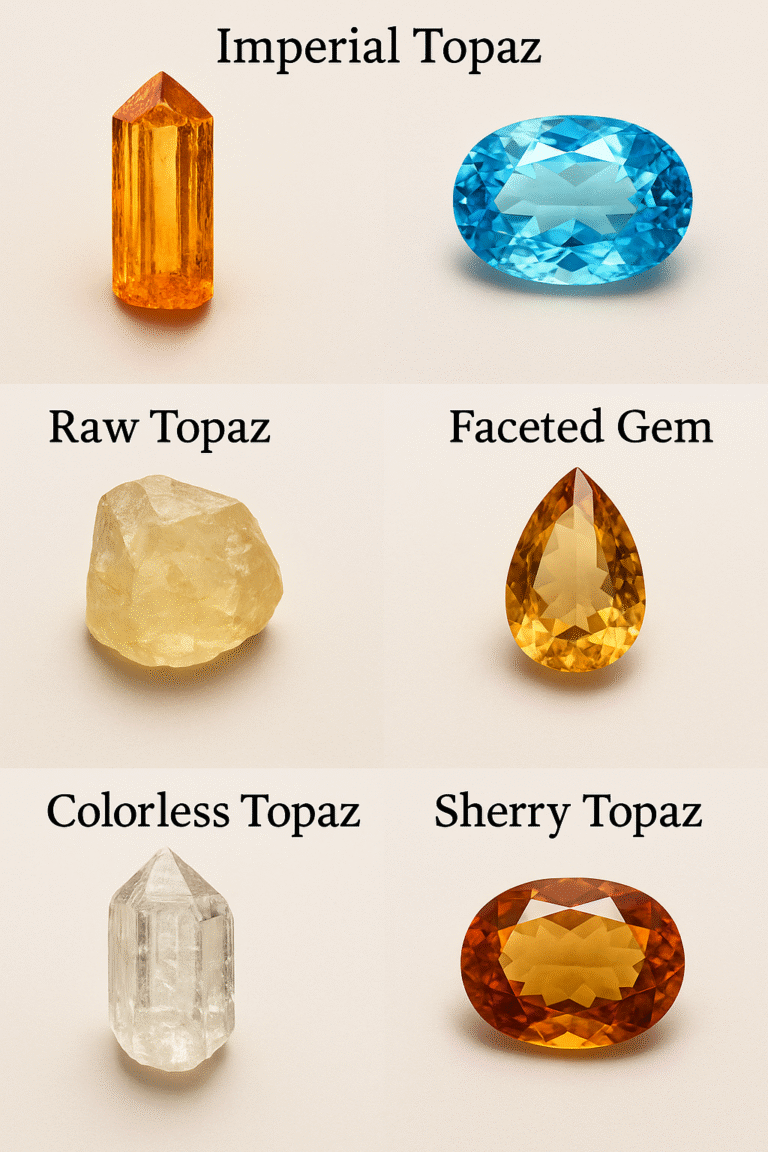Monthly Mineral Spotlight – November
Topaz: The Brilliant Gemstone of Late Autumn
Topaz has long been associated with November, and for good reason. Its warm golden tones, dazzling brilliance, and remarkable clarity echo the final glow of autumn. As one of the most durable and beautiful gemstones found in nature, topaz is cherished by jewelers, collectors, and rockhounds alike.
Whether colorless, champagne-gold, pink, or the famous Imperial orange, topaz stands out as one of the most recognized birthstones in the world.
What Is Topaz?
Topaz is a hard, durable aluminum silicate mineral:
Al₂SiO₄(F,OH)₂
It typically forms in granitic pegmatites, rhyolitic cavities, and high-silica volcanic environments. Fluorine plays a key role in its crystal structure, and tiny structural differences produce its range of colors.
From a rockhound’s perspective, topaz is an excellent mineral for learning about:
pegmatite formation
mineral chemistry
crystal structure
cleavage and fracture
mineral hardness
Natural topaz occurs in a number of colors that appeal to collectors and cutters.
Topaz as the November Birthstone
Topaz has symbolized warmth, strength, creativity, and clarity for thousands of years. Ancient cultures associated golden topaz with the sun, and today it remains the traditional November birthstone.
Because golden, amber, and “sherry” colors resemble autumn leaves, topaz fits the season perfectly.
Topaz Varieties Rockhounds Should Know
Imperial Topaz
Deep golden-orange, pinkish-orange, or reddish tones.
Among the rarest and most valuable forms. Primarily from Brazil.
Colorless Topaz
Common worldwide. Often extremely clear.
Used as the base material for treated blue topaz.
Blue Topaz
Naturally pale but commonly enhanced through safe irradiation and heating.
One of the most popular modern gemstones.
Sherry Topaz
Warm brownish-orange to golden tones — very “November.”
Pink and Red Topaz
Rare and highly sought after. Found mainly in Pakistan, Russia, and Brazil.
Mystic or Coated Topaz
Not natural — color-coated to create rainbow iridescence.
Popular commercially, important to clarify for beginners.
Where Topaz Is Found
Topaz occurs worldwide, especially in pegmatite regions. Key sources include:
United States
Topaz Mountain, Utah – Champagne-colored crystals; a famous rockhounding site
Texas – Colorless and light blue topaz
Colorado – Clear and sherry-toned crystals from alpine pegmatites
California – Pegmatite-hosted colorless topaz
Brazil
The world’s leading producer, especially for Imperial Topaz.
Pakistan & Afghanistan
Exceptional pink, red, and champagne crystals.
Sri Lanka
Known for water-clear topaz crystals.
Russia
Classic locality for deep “sherry” topaz crystals.
Rockhounds interested in pegmatites often encounter topaz alongside quartz, beryl, feldspar, and tourmaline.
Why Topaz Is Important to Collectors
Rockhounds value topaz for:
Its hardness of 8 (very durable)
Large, well-formed crystals
Natural clarity
Beautiful autumn-inspired colors
Strong cultural and birthstone significance
Its presence in classic U.S. collecting sites
Topaz bridges the gap between true rockhounding and traditional gemstone collecting, making it ideal for your monthly spotlight series.
How to Identify Topaz
Topaz can resemble quartz or beryl, but several clues help distinguish it:
Hardness 8 – much harder than quartz
Distinct cleavage – perfect basal cleavage
Heft – heavier than quartz
Crystal shape – orthorhombic prisms, often with striations
High clarity and brilliance
Glassy (vitreous) luster
When unsure, hardness testing and crystal habit are the most reliable indicators.
Uses of Topaz
Topaz has been used historically and today for:
Faceted gemstones
Jewelry settings
Ornamental carvings
Collector specimens
Mineral displays
Birthstone jewelry (November)
With its durability and brilliance, topaz remains one of the premier gemstones after diamond, corundum, and beryl.
Fun Fact
Fun Fact:
Although blue topaz is popular today, naturally deep blue topaz is extremely rare. Most commercial blue topaz began as colorless topaz, which was later irradiated and gently heated to develop its vivid blue color — a fully stable and widely accepted treatment in the gem world.
Conclusion
Topaz is one of the most elegant gemstones in the mineral kingdom. Its warm colors, brilliant clarity, and geological significance make it an ideal mineral to spotlight for November. Whether sparkling in jewelry or discovered as a natural crystal in the field, topaz perfectly embodies the glow and warmth of late autumn.
